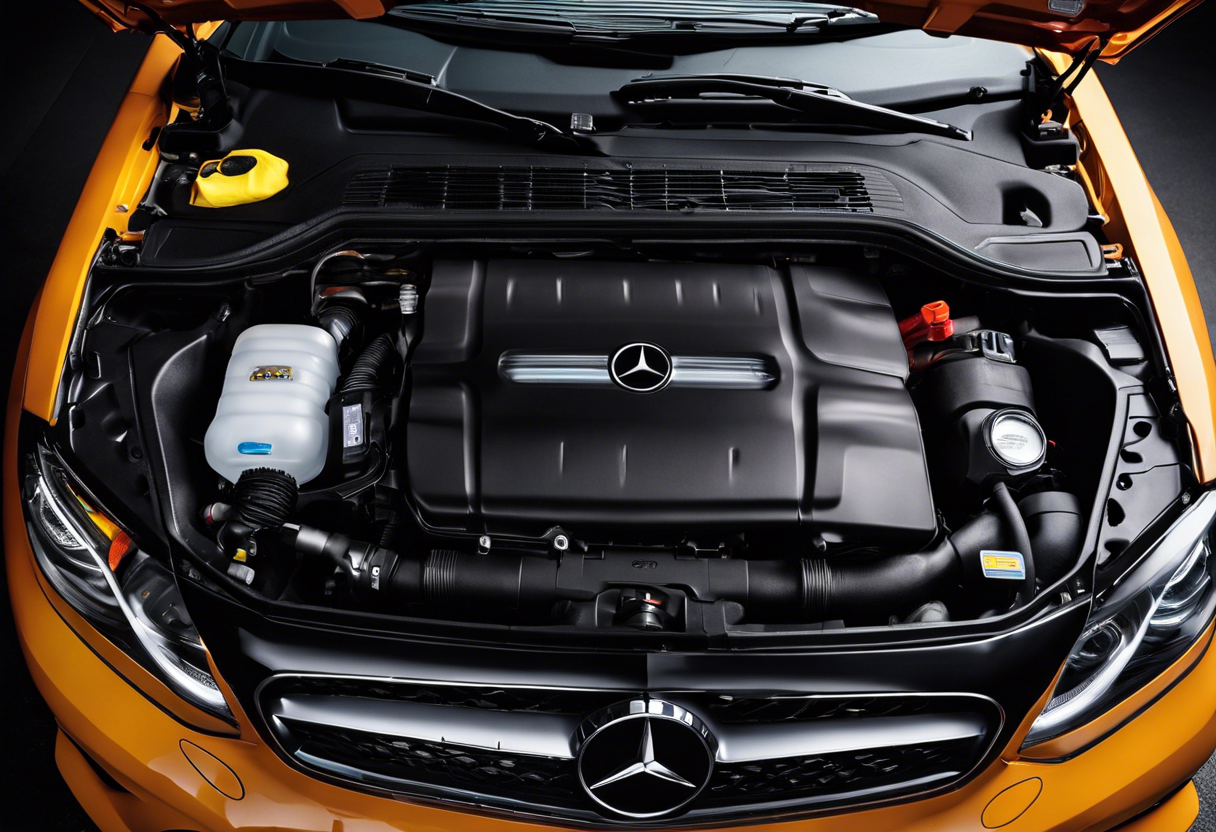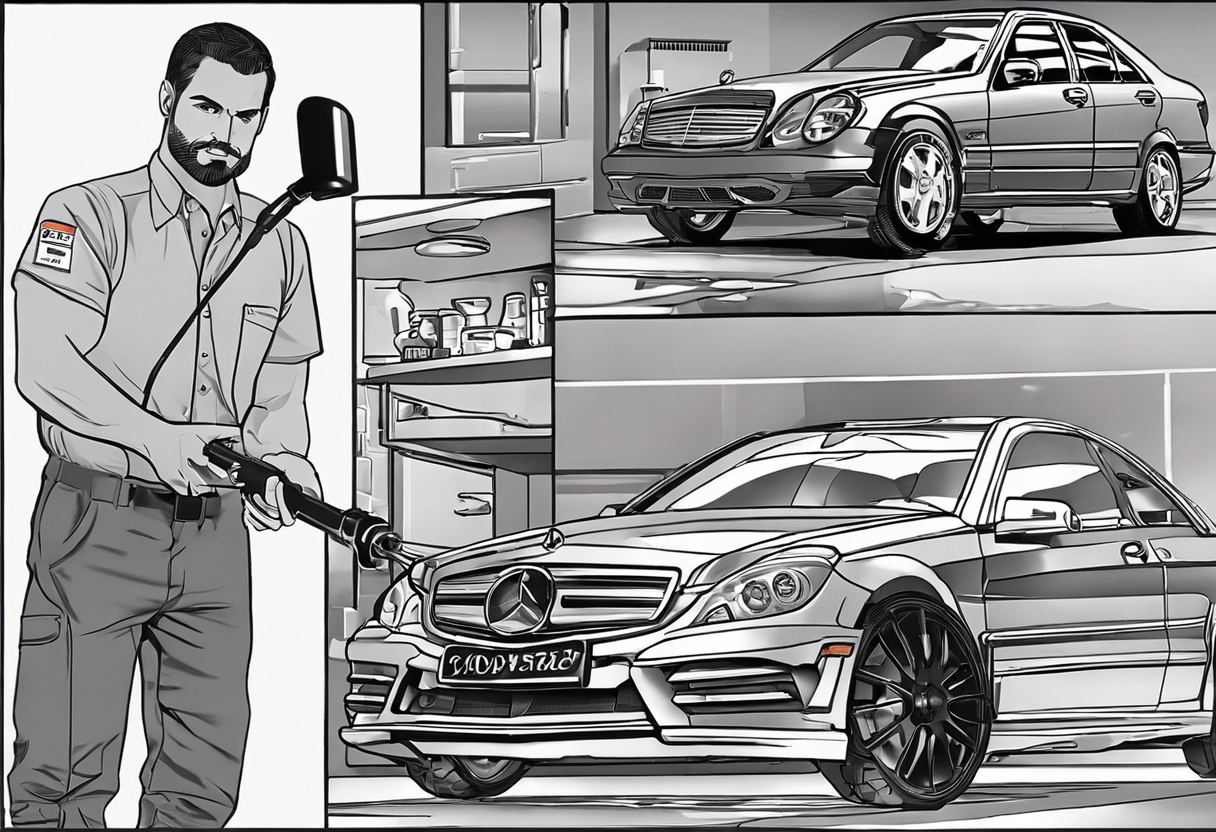![]() Introduction
Introduction
Cooling systems in Mercedes Benz vehicles are crucial for maintaining optimal engine temperatures and preventing overheating. Coolant, a heat transfer fluid, circulates through the engine and radiator, absorbing heat and dissipating it through the radiator fins. Proper levels of coolant ensure efficient system operation, protecting the engine from thermal damage and ensuring peak performance. Insufficient coolant can lead to overheating, engine failure, and costly repairs. Therefore, monitoring and maintaining correct coolant levels in the reservoir are vital for the longevity and reliability of any Mercedes Benz.
Understanding Your Mercedes Benz Coolant Requirements
To ensure the proper functioning of your Mercedes Benz’s engine, it is crucial to use the correct coolant. Mercedes Benz vehicles require a specific type of coolant that offers anti-corrosion properties and is compatible with the engine’s materials. Using non-approved coolant can lead to damage and costly repairs. Here’s what you must know:
- Coolant Type: Mercedes Benz recommends their specially formulated coolant that meets the MB 325.0 or 325.5 specification.
- Mix Ratio: The coolant should typically be mixed with distilled water in a 50:50 ratio.
- Change Intervals: Regular coolant changes, with intervals specified in your owner’s manual, prevent degradation and contamination.
- Monitoring Levels: Check coolant levels at regular intervals and especially before long trips.
- Inspection for Leaks: Routine inspections can identify leaks early, preventing overheating and engine damage.
Using the right coolant and maintenance practice ensures the longevity of your vehicle’s engine and keeps your Mercedes Benz operating at peak efficiency.
Tools and Materials Needed to Top Up Your Coolant
To ensure a proper coolant top-up for your Mercedes Benz, the following tools and materials are required:
- Mercedes Benz Approved Coolant: Check the owner’s manual for the specific type recommended.
- Distilled Water: For diluting the coolant if you’re using a concentrated formula.
- Safety Glasses: To protect your eyes from any splashes.
- Gloves: Ideally nitrile gloves to protect your hands from chemicals.
- Funnel: To pour the coolant into the reservoir without spilling.
- Clean Rag or Towel: For wiping up any spills and cleaning the area around the coolant reservoir cap.
- Coolant Tester: Optional, to check the protection level of your existing coolant.
- Bucket or Drain Pan: In case you need to drain any excess or old coolant.
- Owner’s Manual: For reference to specific instructions related to the vehicle’s coolant system.
Safety Precautions Before You Begin the Coolant Top-Up Process
Before adding coolant to your Mercedes Benz, it’s essential to take the following safety precautions:
- Engine Cooling: Ensure the engine is completely cooled down before attempting to open the coolant reservoir to prevent burns from escaping steam or hot coolant.
- Personal Protective Equipment (PPE): Always wear safety goggles and gloves to protect your eyes and hands from any potential spills or splashes of the coolant, which can be hazardous.
- No Smoking: Work in a well-ventilated area and make sure there’s no smoking or open flames nearby, as the coolant is flammable.
- Correct Coolant Type: Validate that you are using the correct type of coolant for your specific Mercedes Benz model to avoid chemical reactions or damage to the engine.
- Secure Vehicle: Ensure the vehicle is on a stable, level surface and that it is properly secured, ideally with the parking brake on to prevent any movement during maintenance.
- Emergency Plan: Keep a first aid kit and emergency contact numbers within reach in case of an accidental spill or injury.
Taking these precautions seriously is critical to maintain safety and vehicle integrity.
Inspecting the Coolant Level and Assessing the Need for a Top-Up
Maintaining optimal coolant levels is crucial for your Mercedes Benz’s performance. Begin by locating the coolant reservoir under the hood; it’s typically a translucent bottle with measurement markings. With the engine cool, check where the liquid aligns with the markings—there should be a ‘min’ and ‘max’ line. Coolant should sit between these levels. If it falls near or below ‘min,’ a top-up is necessary to maintain proper cooling and prevent overheating. Always use the recommended type of coolant to avoid chemical incompatibility and potential damage to the engine.
Preparing Your Mercedes for Coolant Top-Up
Prior to adding coolant to your Mercedes Benz, ensure the engine is cool to prevent injury from hot fluid or steam. Locate the coolant reservoir; it’s typically a translucent tank with level markings. Confirm the current coolant level against these markers. If low, consult your vehicle’s manual for the recommended type and mixture of coolant. Gather a funnel and a clean cloth to prevent spills and to wipe any excess. Keep a container of distilled water, if the recommended mixture includes it. Always wear protective gloves and safety glasses for safety against chemical exposure.
Step-by-Step Guide to Topping Up Your Mercedes Benz Coolant
- Ensure the engine is cool before unscrewing the reservoir cap to prevent burns from hot coolant or steam.
- Locate the coolant reservoir; typically, it’s a transparent tank with level markings.
- Check the current coolant level; it should be between the “Min” and “Max” marks.
- If the level is low, prepare the appropriate coolant mixture—usually a 50/50 mix of antifreeze and distilled water.
- Slowly add the coolant mixture to the reservoir until it reaches the “Max” marking.
- Replace the reservoir cap and tighten it securely.
- Start the engine, allowing it to reach normal operating temperature, and check for leaks.
- Confirm coolant level remains within the correct range and adjust if necessary after the engine has cooled once again.
Tips for Choosing the Right Coolant for Your Mercedes Benz
- Check the Owner’s Manual: Always consult the vehicle’s owner’s manual for the manufacturer’s coolant specifications to ensure compatibility.
- Use Mercedes-Benz Approved Coolants: Select coolants that are explicitly approved by Mercedes-Benz to avoid potential damage to the engine’s cooling system.
- Consider the Antifreeze Concentration: Choose the correct antifreeze-to-water ratio recommended for your particular climate and driving conditions.
- Opt for Silicate-Free Formulas: Mercedes-Benz engines often require silicate-free coolant to prevent unnecessary wear on water pump seals and other components.
- Avoid Mixing Colors: Stick to the coolant color that is already in use in your vehicle as mixing different colors can lead to chemical reactions and reduce efficiency.
- Quality Matters: Invest in high-quality coolants that provide corrosion protection and are designed for prolonged use, which can save money in the long run on repairs.
How to Check for Leaks After Topping Up Coolant
After topping up the coolant in a Mercedes Benz, it is crucial to check for potential leaks to ensure the cooling system works properly:
- Start the engine and let it reach operating temperature.
- With the engine running, inspect the coolant reservoir for changes in coolant level.
- Look under the vehicle for any signs of liquid pooling on the ground.
- Examine all accessible parts of the cooling system, including hoses and connections, for dampness or coolant residue.
- Sniff for a sweet smell around the engine bay, which may indicate a coolant leak.
- If necessary, use a pressure tester on the cooling system to uncover any hidden or slow leaks.
- Listen for any hissing sounds that may signal a leak while the engine is still warm.
- After the engine cools, recheck all areas for leaks as contraction can expose them.
If a leak is detected at any point, consult a professional mechanic for repair before the issue escalates.
Common Pitfalls to Avoid When Topping Up Coolant
- Not Allowing the Engine to Cool: Attempting to add coolant to a hot engine can lead to injury from steam or hot fluid eruption.
- Using the Wrong Coolant Type: Mercedes-Benz vehicles often require specific coolant formulations to prevent damage to the cooling system and ensure optimal performance.
- Mixing Coolant Colors: Mixing different colors or types of coolant can lead to chemical reactions that may clog or corrode the cooling system.
- Filling Beyond the Max Line: Overfilling the reservoir can cause coolant to overflow when it expands from engine heat, possibly leading to system pressure issues.
- Ignoring a Flush Schedule: Neglecting to flush the system periodically can allow old coolant to become acidic and corrode internal components.
- Neglecting to Check for Leaks: Always inspect for potential leaks after adding coolant, as this may indicate a larger issue within the cooling system.
- Forgetting to Replace the Cap Securely: Failing to securely fasten the reservoir cap can lead to coolant evaporation and system pressure loss.
Additional Cooling System Maintenance Tips for Your Mercedes Benz
- Regularly inspect hoses and belts for signs of wear or damage.
- Ensure the radiator cap seals properly to maintain system pressure.
- Use only recommended Mercedes coolant to prevent corrosion.
- Check the coolant level often; top up with the correct mixture as needed.
- Perform a coolant flush at intervals specified by manufacturer guidelines.
- Consider having the thermostat inspected to ensure proper engine temperature regulation.
- Keep the radiator exterior clean to prevent overheating from blocked airflow.
- Listen for unusual noises that could indicate a failing water pump.
- Schedule yearly inspections with a qualified mechanic to catch potential issues early.
- Always address overheating immediately to avoid severe engine damage.
Understanding the Signs of Cooling System Issues
Mercedes Benz owners need to be vigilant for symptoms of cooling system problems to avoid costly repairs. Key indicators include:
- Overheating Engine: A primary sign of cooling system distress is an engine that runs hotter than normal or overheats.
- Visible Coolant Leaks: Puddles or stains underneath the vehicle can signal a leak in the cooling system.
- Fluctuating Temperature Gauge: Sudden changes in the dashboard temperature reading may imply cooling system inconsistencies.
- Low Coolant Levels: Regularly diminishing coolant levels could suggest leaks or faulty components.
- Heater Malfunction: Inadequate heating inside the cabin can be a telltale sign of cooling system failure.
Early detection and prompt attention to these signs are essential for maintaining the performance and longevity of your Mercedes Benz’s cooling system.
Long-Term Coolant Maintenance for Mercedes Benz Owners
For enduring vehicle health, long-term coolant maintenance is vital for Mercedes Benz owners. Consider these key points:
- Regular Inspection: Bi-annual inspection of the coolant level and condition is advisable to prevent overheating and corrosion.
- Coolant Flush: A coolant flush every 40,000 to 60,000 miles, or per Mercedes Benz’s recommendations, helps maintain system integrity.
- Quality Coolant: Use Mercedes-approved coolant only. This ensures the correct antifreeze protection and corrosion inhibitors for your engine.
- Check for Leaks: Regularly inspect for leaks in the cooling system which can lead to coolant loss and engine damage.
- Professional Assistance: For optimal maintenance, consider having your coolant system checked by a certified Mercedes Benz technician during service appointments.
FAQs About Mercedes Benz Coolant
Conclusion:
Proper maintenance of the coolant reservoir in a Mercedes Benz ensures vehicle longevity and peak performance. Owners should routinely:
- Check coolant levels, and refill if necessary
- Inspect for leaks and reservoir damage
- Use only Mercedes-approved coolant to avoid corrosion
- Flush and replace coolant according to the service schedule
- Consult a professional mechanic for inspection and repairs
By adhering to these practices, Mercedes Benz owners can maintain their vehicle’s cooling system efficiency, prevent overheating, and safeguard engine integrity.
for more info : https://manualwheel.com/what-is-a-valve-…-is-it-important/
for more info : https://www.youtube.com/watch?v=lB4Gr20BUck

